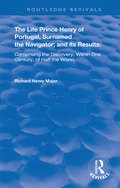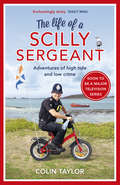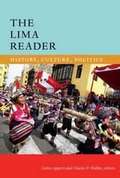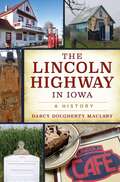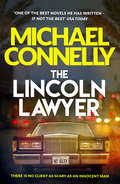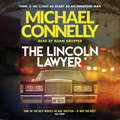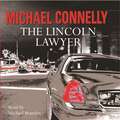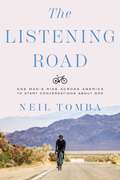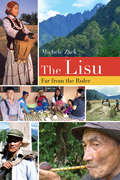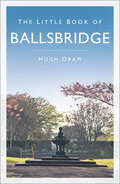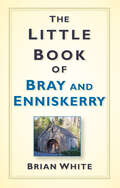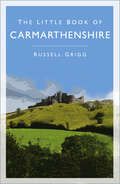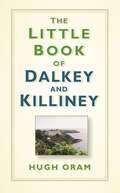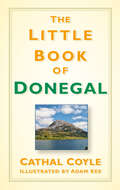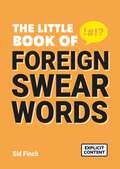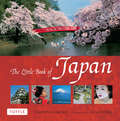- Table View
- List View
The Life of Prince Henry of Portugal: Surnamed the Nabigator and its Results (Routledge Revivals)
by Richard Henry MajorOriginally published in 1868, this book follows the life of Prince Henry, including chapters on the Siege of Tangier, the capture of Ceuta and the death of Prince Henry.
The Life of a Scilly Sergeant
by Colin Taylor‘Policing is like this everywhere but not everywhere is Scilly’Meet Sergeant Colin Taylor, he has been a valuable member of the police force for over 20 years, 5 of which have been spent policing the ‘quiet’ Isles of Scilly, a group of islands off the southwestern tip of the Cornish peninsula. Colin has made it his purpose to keep the streets of Scilly free from drunk anchor thieves, Balance Board riders and other culprits, mostly drunken, intent on breaking the law. This book is the first hand account of how he did it.Coupled with his increasingly popular ‘Isle of Scilly Police Force’ Facebook page, this book charts the day to day trials and tribulations of a small-island police officer, told in a perfectly humorous and affectionate way. This book is a fantastic read and Colin's antics are soon to be the feautre of a major ITV TV series.
The Lima Reader: History, Culture, Politics
by Carlos Aguirre Charles F. WalkerCovering more than five hundred years of history, culture, and politics, The Lima Reader captures the multiple viewpoints of the diverse peoples of Peru’s capital city. The volume traces Lima’s transformation from a pre-Columbian religious center, to the colonial “City of Kings,” to today's vibrant and deeply divided metropolis of almost ten million people. A rich array of primary sources—including traveler accounts, essays, photographs, maps, poems, short stories, lyrics, and memoir excerpts, many appearing in English for the first time—address how Lima’s multiethnic population, class inequalities, and debates of who is a “true” limeño/a have evolved throughout the city’s history. The book also includes selections that explore Lima’s identity through its food, sports culture, festivals, and sense of humor. Intended for travelers, students, and scholars alike, The Lima Reader is an invaluable introduction to the complex social tensions and cultural history of Lima and its people.
The Lincoln Highway in Iowa: A History (Transportation)
by Darcy Dougherty MaulsbyIowa's Great Highway Before there was Route 66, there was the iconic Lincoln Highway. A symbol of limitless potential, America's first coast-to-coast highway spanned Iowa from the Mississippi River to the Missouri River. When you travel U.S. 30 across Iowa today, you're never far from the historic Lincoln Highway, if not right on top of it. Learn the history of an Iowa landmark.
The Lincoln Lawyer: A Richard and Judy bestseller (Mickey Haller Series #1)
by Michael ConnellyThere is no client as scary as an innocent man...Mickey is a Lincoln Lawyer - a criminal defence attorney operating out of the back of his car, a Lincoln - taking whatever cases the system throws at him. He's been a defence lawyer for a long time, and he knows just how to work the legal system. When a Beverly Hills rich boy is arrested for brutally beating a woman, Haller gets his first high-paying client in years. The evidence mounts on the defence's side, and Haller might even be in the rare position of defending a client who is actually innocent.But then the case starts to fall apart. And neither the suspect nor the victim are quite who they seem, and Haller quickly discovers that when you swim with the sharks, you might just end up as prey...
The Lincoln Lawyer: A Richard and Judy bestseller (Mickey Haller Series #1)
by Michael ConnellyA major motion picture starring Matthew McConaughey. There is no client as scary as an innocent man. From the bestselling author of THE GODS OF GUILT and BRASS VERDICT comes the first in the Mickey Haller legal thrillers. Mickey is a Lincoln Lawyer, a criminal defence attorney who operates out of the back of his car, a Lincoln, taking whatever cases the system throws in his path. He's been a defence lawyer for a long time, and he knows just how to work the legal systems. When a Beverly Hills rich boy is arrested for brutally beating a woman, Haller has his first high-paying client in years. The evidence mounts on the defence's side, and Haller might even be in the rare position of defending a client who is actually innocent.But then the case starts to fall apart, neither the suspect nor the victim are quite who they seem - and Haller quickly discovers that when you swim with the sharks, it's easy to wind up as prey.
The Lincoln Lawyer: A Richard and Judy bestseller (Mickey Haller Series #1)
by Michael ConnellyA major motion picture starring Matthew McConaughey. There is no client as scary as an innocent man. From the bestselling author of THE GODS OF GUILT and BRASS VERDICT comes the first in the Mickey Haller legal thrillers. Mickey is a Lincoln Lawyer, a criminal defence attorney who operates out of the back of his car, a Lincoln, taking whatever cases the system throws in his path. He's been a defence lawyer for a long time, and he knows just how to work the legal systems. When a Beverly Hills rich boy is arrested for brutally beating a woman, Haller has his first high-paying client in years. The evidence mounts on the defence's side, and Haller might even be in the rare position of defending a client who is actually innocent.But then the case starts to fall apart, neither the suspect nor the victim are quite who they seem - and Haller quickly discovers that when you swim with the sharks, it's easy to wind up as prey.Read by Michael Brandon(p) 2005 Orion Publishing Group
The Listening Road: One Man's Ride Across America to Start Conversations About God
by Neil TombaIn today&’s contentious social climate, is it possible to talk to people—whether strangers or friends—about life&’s deepest and most sensitive topics? In The Listening Road, you&’ll ride along on one man's remarkable 33-day journey cycling across the United States on a mission to engage with people from all walks of life in real conversations about things that matter most.As a pastor, Neil Tomba noticed a disturbing trend among people in church: they were finding it increasingly difficult to talk about God to those outside of the church. Neil wanted to practice what he preached, so he set out to bike across the United States, talking—and, more importantly, listening—to strangers from all walks of life about faith, their stories, and matters of the heart.The Listening Road takes you on Neil&’s remarkable journey across the country and straight into its soul—from Route 66 motels to state parks, a lake house, and a railway car; from conversations with Amish farmers to chats with truckers, cowboys, mechanics, and a descendant of Daniel Boone. From one city, farm, and highway to the next, we discoverpractical ways to change our posture toward others to foster conversation,why curiosity, kindness, and respect open up communication about God, andhow even in a culture of division and antagonism, real connection is possible.In our polarizing time, Neil models with compassion and curiosity that genuine connection happens if only we are willing to listen in love.
The Lisu: Far from the Ruler
by Michele ZackThis book brings the ironic worldview of the Lisu to life through vivid, often amusing accounts of individuals, communities, regions, and practices. One of the smallest and last groups of stateless people, and the most egalitarian of all Southeast Asian highland minorities, the Lisu have not only survived extremes at the crossroads of civil wars, the drug trade, and state-sponsored oppression but adapted to modern politics and technology without losing their identity. The Lisu weaves a lively narrative that condenses humanity’s transition from border-free tribal groupings into today’s nation-states and global market economy. Journalist and historian Michele Zack first encountered the Lisu in the 1980s and conducted research and fieldwork among them in the 1990s. In 2014 she again traveled extensively in tribal areas of Thailand, Myanmar, and China, when she documented the transformative changes of globalization. Some Lisu have adopted successful new urban occupations in business and politics, while most continue to live as agriculturists “far from the ruler.” The cohesiveness of Lisu culture has always been mysterious—they reject hierarchical political organization and traditionally had no writing system—yet their culture provides a particular skillset that has helped them navigate the terrain of the different religious and political systems they have recently joined. They’ve made the transition from living in lawless, self-governing highland peripheries to becoming residents and citizens of nation-states in a single generation. Ambitious and written with journalist’s eye for detail and storytelling, The Lisu introduces the unique and fascinating culture of this small Southeast Asian minority. Their path to national and global citizenship illustrates the trade-offs all modern people have made, and their egalitarian culture provides insight into current political choices in a world turning toward authoritarianism.
The Little Black Book of Motorcycle Wisdom (Little Red Books)
by Malcolm NelsonThere’s no getting around the allure of motorcycles. Since 1885, when Gottlieb Daimler mounted a gas-powered engine on a wooden bicycle, riders of all ages have been drawn to the exhilaration and terror of motoring in the open air on two wheels. Motorcycles have become ingrained in our culture. To some, they are the ultimate expression of freedom. To others, motorcycles symbolize lawlessness and disrespect for authority.The Little Black Book of Motorcycle Wisdom is packed full of wise, witty, and edgy quotes on motorcycles and the people who ride them. Celebrities, literary giants, and athletes offer pithy and memorable comments on what they ride, where they ride, with whom they ride, how fast they ride—and, most importantly, why they ride. Read musings on bikes from such noteworthy folks as: Hunter S. ThompsonMarlon BrandoRobert PirsigEvel KnievelSonny BargerEwan McGregorSteve McQueenLeonardo DiCaprioPaul NewmanBob DylanHugh LaurieAngelina JolieT. E. LawrenceAnd dozens of others!There’s a reason why people the world over are passionate about a machine that has been dubbed “the perfect vehicle.” This book tells you why.
The Little Blue Book of Travel Wisdom (Little Red Books)
by Julie GanzFrom the early explorers to space travelers and holiday jetsetters, those in transit have acknowledged both the benefits and downsides of life on the go. The Little Blue Book of Travel Wisdom is a collection of these musings on travel, be it for research purposes, business, or vacation, via a plane, a bus, or a train. Just some of the figures cited in the book include: Robert Frost Mark Twain Maya Angelou Pat Conroy Rick Steves Ivanka Trump John Steinbeck Angelina Jolie Oscar Wilde Michael Crichton Jerry Seinfeld Clay Aiken And so many more!
The Little Book of Ballsbridge (Little Book Of)
by Hugh OramThe Little Book of Ballsbridge is a compendium of fascinating, obscure, strange and entertaining facts about this leafy suburb of Dublin. Here you will find out about Ballsbridge’s famous (and occasionally infamous) residents, its proud sporting heritage, its churches and great houses and its natural history. Down wide streets and past elegant houses, this book takes the reader on a journey through Ballsbridge and its vibrant past. A reliable reference book and a quirky guide, this can be dipped into time and time again to reveal something new about the people, the heritage and the secrets of Dublin’s ‘embassy belt’.
The Little Book of Birmingham (Little Book Of)
by Norman BartlamThe Little Book of Birmingham is a funny, fast-paced, fact-packed compendium of the sort of frivolous, fantastic or simply strange information which no-one will want to be without. Here we find out about the city’s most unusual crimes and punishments, eccentric inhabitants, famous sons and daughters and literally hundreds of wacky facts. Norman Bartlam’s new book gathers together a myriad of data on Brum. There are lots of factual chapters but also plenty of frivolous details which will amuse and surprise. A reference book and a quirky guide, this can be dipped in to time and time again to reveal something you never knew. This is a remarkably engaging little book, and is essential reading for visitors and locals alike.
The Little Book of Bray and Enniskerry
by Brian WhiteThe Little Book of Bray & Enniskerry is a compendium of fascinating, obscure, strange and entertaining facts. Here you will find out about Bray and Enniskerry's history, their famous faces, their buildings and streets, their sporting heritage and their myths and legends. Through main thoroughfares and twisting back streets, this book takes the reader on a journey through the area's past.A reliable reference book and a quirky guide, this can be dipped into time and time again to reveal something new about the people, the heritage and the secrets of these ancient settlements.
The Little Book of Canada: Mounties, Moose And Maple Syrup (The\little Book Of... Ser.)
by Orange Hippo!Canada is repeatedly ranked the world's most favourite tourist destination. And there's a lot of reasons why. It is a nation of vast, unspoiled wilderness, and yet you still get the feeling everyone still knows each other's name. It has a ton of bears. And maple syrup. And lakes. Great lakes, the best. And a handsome, competent Prime Minister.The Little Book of Canada – a compact companion stuffed to the Gills (a common Canadian surname, FYI) with so much fun stuff you'll pass your citizenship test with flying colours. This tiny tome celebrates almost everything that is unique, special, and 'nice' about Canada because, quite frankly, Canada deserves it more than any other place on earth.'I believe the world needs more Canada.' Bono'Canada is the essence of not being. Not English, not American, it is the mathematics of not being.' Mike Myers
The Little Book of Canada: Mounties, Moose And Maple Syrup (The\little Book Of... Ser.)
by Orange Hippo!Canada is repeatedly ranked the world's most favourite tourist destination. And there's a lot of reasons why. It is a nation of vast, unspoiled wilderness, and yet you still get the feeling everyone still knows each other's name. It has a ton of bears. And maple syrup. And lakes. Great lakes, the best. And a handsome, competent Prime Minister.The Little Book of Canada – a compact companion stuffed to the Gills (a common Canadian surname, FYI) with so much fun stuff you'll pass your citizenship test with flying colours. This tiny tome celebrates almost everything that is unique, special, and 'nice' about Canada because, quite frankly, Canada deserves it more than any other place on earth.'I believe the world needs more Canada.' Bono'Canada is the essence of not being. Not English, not American, it is the mathematics of not being.' Mike Myers
The Little Book of Carmarthenshire (Little Book Of)
by Russell GriggDid You Know?Carmarthen is believed to be the oldest town in Wales. The first canned beer in the United Kingdom was produced in Llanelli. The National Botanic Garden of Wales has the largest single-span glasshouse in the world. Fast-paced and fact-packed, this compendium revels in Carmarthenshire's rich heritage and what makes it special in areas such as culture, landscape, wildlife, food and sport.This whistle-stop tour through the ‘Garden of Wales’ covers both celebrated characters and murky pasts, taking in the county’s breathtaking castles, nature reserves and famous landmarks along the way. From the county gaol and asylum to school strikes and industrial riots, this is a book you won’t want to put down.
The Little Book of Dalkey and Killiney
by Hugh OramDiscover a delightful and unspoiled seaside village through this fact-packed compendium. Renowned for its castle, book festival and nearby island, Dalkey and neighbouring Killiney Hill Park have plenty of special places to find and history to uncover. A reliable reference book and a quirky guide, The Little Book of Dalkey and Killiney can be dipped into time and time again to reveal something new about the people, the heritage and the secrets of this charming coastal area.
The Little Book of Donegal
by Cathal Coyle Adam KeeThe Little Book of Donegal is a compendium of fascinating, obscure, strange and entertaining facts about County Donegal. Here you will find out about Donegal’s folklore and customs, its proud sporting heritage, its castles, forts and stone circles, its famous (and occasionally infamous) men and women. Through quaint villages and historic towns and along the ‘Wild Atlantic Way’, this book takes the reader on a journey through County Donegal and its vibrant past. A reliable reference book and a quirky guide, this can be dipped into time and time again to reveal something new about the people, the heritage and the secrets of this ancient county.
The Little Book of Foreign Swear Words
by Sid FinchEver been lost for words abroad?When you want to get your point across abroad there’s only one way to do it: by swearing your ar*e off! Impress the world with a stream of multi-lingual profanity from this nifty pocket book.
The Little Book of Foreign Swear Words
by Sid FinchEver been lost for words abroad?When you want to get your point across abroad there’s only one way to do it: by swearing your ar*e off! Impress the world with a stream of multi-lingual profanity from this nifty pocket book.
The Little Book of Glasgow (Little Book Of)
by Geoff HolderThe Little Book of Glasgow is a funny, fast-paced, fact-packed compendium of the sort of frivolous, fantastic or simply strange information which no-one will want to be without. Here we find out about the most unusual crimes and punishments, eccentric inhabitants, famous sons and daughters and literally hundreds of wacky facts. Geoff Holder’s new book gathers together a myriad of data on Glasgow. There are lots of factual chapters but also plenty of frivolous details which will amuse and surprise. A reference book and a quirky guide, this can be dipped in to time and time again to reveal something you never knew. Discover why two archbishops had a fight on the steps of the cathedral, find directions to an Egyptian pharaoh and a Native American chief, and learn where you can find half-a-dozen Tardises. A remarkably engaging little book, this is essential reading for visitors and locals alike.
The Little Book of Japan
by Charlotte Anderson Gorazd VilharJapan is a country shrouded in mystery, even now in the 21st century. The myriad facets that, when put together, compose the whole of this nation are impossible to fully capture. But in The Little Book of Japan, the dynamic photographer-writer team of Gorazd Vilhar and Charlotte Anderson do a beautiful job of creating a celebration in words and images that encapsulates what makes this country so extraordinary.Small and easily portable, The Little Book of Japan is organized in a series of 44 essays contained within four chapters: Cultural Icons, Traditions, Places and Spiritual Life. Under these four overarching ideals, Vilhar and Anderson explore a wide range of topics from Japanese cultural icons and traditions to Japan's spiritual life to its unique cities and villages. Broad enough to satisfy anyone with an interest in the culture, art, and beliefs of this unique island nation, yet comprehesive enough for the true Japanophile, The Little Book of Japan is a stunning collection of photographs and thoughful essays. With everything from Cherry Blossoms to Sushi, Calligraphy to Kimonos, Old Tokyo to Hiroshima, to intimate details of Buddhism and Pilgrimages, this book is a beautiful and enjoyable way to learn more about the fascinating island nation of Japan.

